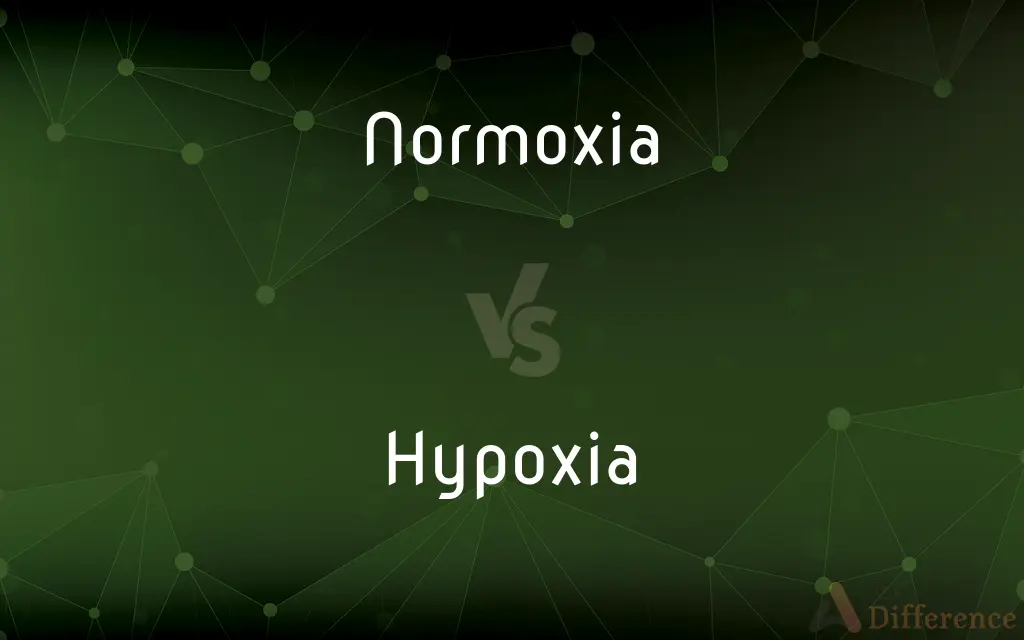Normoxia vs. Hypoxia — What's the Difference?
By Fiza Rafique & Urooj Arif — Updated on March 31, 2024
Normoxia refers to the condition of having normal levels of oxygen in tissues, essential for cellular function, while hypoxia denotes reduced oxygen availability, potentially leading to cellular distress or damage.

Difference Between Normoxia and Hypoxia
Table of Contents
ADVERTISEMENT
Key Differences
Normoxia describes a state where tissues receive an adequate supply of oxygen, which is crucial for the maintenance of cellular metabolism and overall health. On the other hand, hypoxia occurs when the oxygen supply is insufficient, leading to a range of physiological and pathological responses as cells struggle to maintain function.
Medical conditions can also lead to hypoxia, such as respiratory diseases or circulatory problems, where the delivery of oxygen to tissues is compromised. Normoxia, in these cases, is the goal of treatment, aiming to restore oxygen levels to prevent tissue damage and support recovery.
Researchers often study the effects of hypoxia on the human body to understand and develop treatments for conditions where oxygen delivery is impaired. Normoxia serves as a control condition in these studies, providing a baseline for comparison.
In terms of cellular response, hypoxia activates a variety of adaptive mechanisms, including the upregulation of genes involved in increasing oxygen delivery or facilitating metabolic adjustments to low oxygen. In normoxic conditions, these adaptive responses are unnecessary, and cellular processes proceed optimally.
Comparison Chart
Oxygen Level
Normal oxygen levels in tissues
Reduced oxygen availability to tissues
ADVERTISEMENT
Physiological State
Supports cellular metabolism and health
Leads to cellular distress or adaptive changes
Environmental Context
Standard atmospheric oxygen levels
Reduced oxygen pressure, e.g., high altitudes
Medical Relevance
Ideal state for physiological function
Associated with diseases, requires intervention
Cellular Response
Cellular processes proceed optimally
Activation of adaptive mechanisms
Compare with Definitions
Normoxia
The goal in medical treatment to ensure tissue health.
Oxygen therapy aims to restore normoxia in patients.
Hypoxia
Associated with various medical conditions and emergencies.
Chronic lung diseases can cause systemic hypoxia.
Normoxia
The condition of experiencing standard atmospheric oxygen levels.
At sea level, people live in a state of normoxia.
Hypoxia
Affects physical and cognitive functions negatively.
Hypoxia can impair judgment and motor coordination.
Normoxia
Adequate oxygenation of tissues for healthy cellular function.
Normoxia in tissues ensures efficient metabolism.
Hypoxia
A condition marked by insufficient oxygen supply to tissues.
Mountaineers can experience hypoxia at high altitudes.
Normoxia
Essential for optimal physiological and cognitive performance.
Normoxia supports peak athletic performance.
Hypoxia
Studied for understanding and treating oxygen-related disorders.
Research into hypoxia has led to advancements in treatments for stroke victims.
Normoxia
Baseline condition for scientific studies on oxygenation.
Studies often compare cellular function under normoxia and hypoxia.
Hypoxia
Leads to potential cellular distress and adaptive responses.
Hypoxia triggers the release of erythropoietin to increase oxygen carrying capacity.
Normoxia
(physiology) The condition of having a normal level of oxygen
Hypoxia
Deficiency in the amount of oxygen reaching body tissues.
Hypoxia
Depletion of dissolved oxygen in aquatic environments to levels that are detrimental or fatal to aerobic organisms, often caused by eutrophication.
Hypoxia
A reduced concentration of dissolved oxygen in an aquatic environment.
Common Curiosities
What are common causes of hypoxia?
Common causes include high altitude, respiratory diseases, circulatory issues, and environmental factors reducing oxygen levels.
Why is normoxia important for health?
Normoxia ensures that cells receive sufficient oxygen to maintain metabolism and overall physiological health.
How do cells respond to hypoxia?
Cells respond by activating adaptive mechanisms, like upregulating genes to increase oxygen delivery and adjusting metabolism to cope with reduced oxygen.
Is hypoxia always harmful?
While often harmful, mild or controlled hypoxia can have beneficial effects, like enhanced endurance or induced adaptive responses for health benefits.
How do athletes train to adapt to hypoxia?
Athletes may train at high altitudes or use hypoxic training devices to improve their oxygen utilization and performance.
What defines normoxia?
Normoxia is defined by having normal, adequate levels of oxygen in tissues, supporting essential cellular functions.
How does hypoxia affect the body?
Hypoxia leads to reduced oxygen supply to tissues, potentially causing cellular distress, impaired function, and activation of adaptive responses.
What environmental conditions can cause hypoxia?
Conditions like confined spaces, poor ventilation, or exposure to certain chemicals can lead to hypoxia.
How does hypoxia impact athletic training?
It can stimulate adaptive responses that improve oxygen delivery and utilization, potentially enhancing performance.
Can hypoxia be treated?
Yes, treatments aim to restore normoxia, such as supplemental oxygen, medication to improve breathing or circulation, and addressing underlying conditions.
What is the difference between hypoxia and anoxia?
Hypoxia is reduced oxygen availability, while anoxia is the absence of oxygen, a more severe condition.
Can hypoxia be temporary?
Yes, temporary hypoxia can occur during activities like diving or high-altitude exposure but is usually reversible with no long-term effects.
Can living at high altitudes lead to chronic hypoxia?
Yes, but individuals can acclimate over time, developing physiological adaptations to cope with reduced oxygen levels.
What role does normoxia play in recovery from illness?
Restoring normoxia is crucial for recovery from illnesses that impair oxygenation, supporting tissue healing and function.
Share Your Discovery

Previous Comparison
Construe vs. Construct
Next Comparison
Apprised vs. AwareAuthor Spotlight
Written by
Fiza RafiqueFiza Rafique is a skilled content writer at AskDifference.com, where she meticulously refines and enhances written pieces. Drawing from her vast editorial expertise, Fiza ensures clarity, accuracy, and precision in every article. Passionate about language, she continually seeks to elevate the quality of content for readers worldwide.
Co-written by
Urooj ArifUrooj is a skilled content writer at Ask Difference, known for her exceptional ability to simplify complex topics into engaging and informative content. With a passion for research and a flair for clear, concise writing, she consistently delivers articles that resonate with our diverse audience.















































